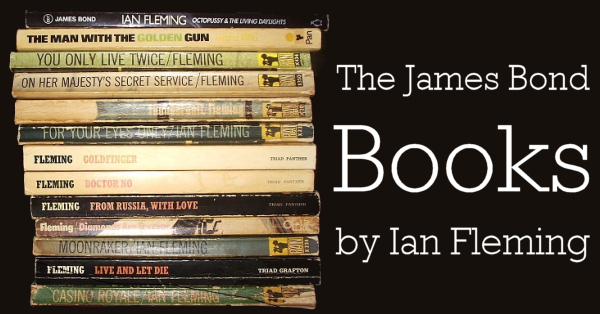Reading the James Bond books in order of publication unveils an evolution of Ian Fleming’s hero.

The world of spy thrillers would not be complete without the iconic character of James Bond. Ian Fleming said he started writing Casino Royale, the first of the James Bond books, in order to take his mind off his impending wedding. In doing so he captivated readers and left an indelible mark on popular culture.
In this article, we delve into the fascinating world of the James Bond books, exploring the genesis of the character, the evolution of the series, and its enduring legacy.
Ian Fleming’s James Bond books in order of publication
Ian Fleming’s 14 James Bond books were first published in the UK by Jonathan Cape and in the US by Macmillan.
Casino Royale (1953 UK/1954 US)
The inaugural James Bond adventure introduces readers to the suave and enigmatic secret agent as he takes on Le Chiffre in a high-stakes game of baccarat, setting the stage for the iconic series.
Live And Let Die (1954 UK/1955 US)
Bond navigates the treacherous world of crime and voodoo in pursuit of Mr Big, a dangerous criminal kingpin with connections that extend from Harlem and reach deep into the Caribbean.
Moonraker (1955)
The third Bond novel sees 007 on home territory as he investigates a multimillionaire who has funded a missile for Britain designed as an independent nuclear deterrent.
Diamonds Are Forever (1956)
Bond’s mission takes him from smuggling diamond into New York to the glitzy casinos of Las Vegas, offering a captivating blend of intrigue and adventure.
From Russia, With Love (1957)
In a tale of Cold War espionage, Bond faces off against the deadly Russian agent Red Grant and the mysterious SMERSH – death to spies.
Dr No (1958)
The exotic backdrop of Jamaica provides the setting for Bond’s clash with the enigmatic Dr No, a nefarious figure bent on disrupting American rocket launches.
Goldfinger (1959)
Bond takes on the gold smuggler Auric Goldfinger – and card cheat – whose grand scheme threatens the world’s financial stability.
For Your Eyes Only (1960)
A collection of five short stories, For Your Eyes Only presents Bond in a series of gripping short adventures.
Thunderball (1961)
When two nuclear warheads are stolen by the mysterious SPECTRE organization, Bond is sent to the Bahamas to track them down down and eventually leading to an underwater confrontation.
The Spy Who Loved Me (1962)
The Spy Who Loved Me is unique in that it features Bond from the perspective of a female protagonist, Vivienne Michel, as she finds her life in danger.
On Her Majesty’s Secret Service (1963)
Bond’s quest to dismantle the villainous Blofeld’s criminal empire, SPECTRE, takes a personal turn as he becomes romantically entangled with his future wife.
You Only Live Twice (1964)
Bond is sent to Japan on a diplomatic mission, only to end up confronting Blofeld once again. The book is an intriguing fusion of Eastern traditions and Western espionage.
The Man With The Golden Gun (1965)
Bond’s faces both personal and professional challenges in Fleming’s final novel as he is sent to the Caribbean to track down the notorious killer, Francisco Scaramanga.
Octopussy & The Living Daylights (1966)
This collection originally included two short stories but recent editions contain two more, offering readers a look at other facets of the character.
Fleming was born in 1908 and led a life as intriguing as his fictional creation. Before becoming a renowned author, Fleming worked as a journalist and served as a senior naval intelligence officer during World War II. His experiences in the intelligence community laid the foundation for his gripping tales of espionage. Each book offers a unique blend of action, suspense, and intricate plots. Fleming’s distinctive writing style with meticulous attention to detail and vivid descriptions immerse readers in a world of exotic locations and larger-than-life characters.
Central to the success of the James Bond series is the character’s evolution throughout the books. Initially portrayed as a suave and ruthless secret agent, Bond gradually reveals layers of complexity, making him more relatable and human. From his vices to his vulnerabilities, Bond’s character reflects the shades of grey that define the human condition.
The Bond books introduced a range of elements that have become synonymous with the series. From Bond’s fast cars, exotic locations and glamourous women to his exacting preferences for food and drink, these details contribute to the larger-than-life image of the character. Equally significant are the memorable villains Bond encounters and the intriguing allies and romantic interests that add depth to the narratives.
Through captivating storytelling, Fleming created a character that has become a symbol of suave sophistication, thrilling adventures, and the eternal struggle between good and evil. Bond’s legacy continues to captivate audiences, making him a timeless icon in the pantheon of literary and cinematic heroes.
Looking for more info on the James Bond books? Check out the list of articles below:
Related pages
Other books
1963, Ian Fleming The Book of Bond (or Every Man his Own 007)
1965, Lt-Col William (“Bill”) Tanner
The James Bond Bedside Companion
1984, Raymond Benson
Annotations and Chronologies for Ian Fleming’s Bond Stories
2005, John Griswold
James Bond Encyclopedia
2007, John Cork & Collin Stutz
007 James Bond: A Report
1964, OF Snelling
On the Tracks of 007
2008, Martijn Mulder and Dirk Kloosterboer


 When Ian Fleming sat down to write the “spy story to end all spy stories” little could he have imagined the phenomenon that would result.
When Ian Fleming sat down to write the “spy story to end all spy stories” little could he have imagined the phenomenon that would result. A guide to get you started finding and appraising first edition James Bond books.
A guide to get you started finding and appraising first edition James Bond books. Anthony Horowitz’s books are just the latest addition in a long line of James Bond continuation novels started following the death of Ian Fleming.
Anthony Horowitz’s books are just the latest addition in a long line of James Bond continuation novels started following the death of Ian Fleming. Every single book by every author in the expanded James Bond literary series.
Every single book by every author in the expanded James Bond literary series. A look at the best books on James Bond published from the 1960s right up to the modern day.
A look at the best books on James Bond published from the 1960s right up to the modern day. Ian Fleming ensured his immortality when he sat down while on holiday in Jamaica and started to write his first novel.
Ian Fleming ensured his immortality when he sat down while on holiday in Jamaica and started to write his first novel. Here you can find links to book reviews and articles on books featuring or about James Bond.
Here you can find links to book reviews and articles on books featuring or about James Bond.







